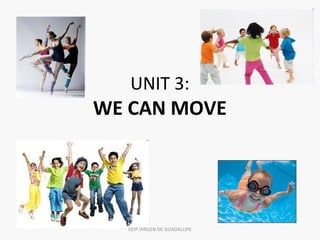
Unit 3 we can move
- 1. UNIT 3: WE CAN MOVE CEIP.VIRGEN DE GUADALUPE
- 2. Our body is made up of our head, torso and limbs. head torso limbs And we can move our body in many ways. CEIP.VIRGEN DE GUADALUPE
- 3. We can stand up and sit down, walk, run and jump. We can move our faces to smile and to eat. CEIP.VIRGEN DE GUADALUPE
- 4. The locomotor system is what lets us move. The locomotor system includes: • bones, • joints • and muscles. CEIP.VIRGEN DE GUADALUPE
- 5. All the bones in our body make up the skeleton. Muscles and joints allow us to move our bones. CEIP.VIRGEN DE GUADALUPE
- 6. The skeleton is made up of all the bones in our body. An adult has 206 bones, but a baby has more. Bones are hard and rigid. They are strong and don’t bend. The skeleton has three parts: • the skull, • the torso • and the limbs. CEIP.VIRGEN DE GUADALUPE
- 7. The skeleton has two functions: 1. It supports our body. 2. It protects the delicate organs inside our body. CEIP.VIRGEN DE GUADALUPE
- 8. The skull protects our brain. The ribs protect our heart and lungs. CEIP.VIRGEN DE GUADALUPE
- 9. The bones in our body are all different shapes. There are three types of bones: 1. Some are long. There are long bones in our arms and legs. 2. Some are short. There are short bones in our spine, hands and feet. 3. And others are flat. Our skull, scapula and pelvis are made of flat bones. CEIP.VIRGEN DE GUADALUPE
- 10. Our bones are connected at joints. • Some joints allow our bones to move a lot. We call these flexible joints: – Knees – shoulders – elbows. • Some joints only allow our bones move a little. We call these semi-flexible joints: – spine. • Some bones are connected at joints that can’t move. We called these fixed joints: – skull. CEIP.VIRGEN DE GUADALUPE
- 11. • Most muscles are connected to bones. They move our bones by contracting and relaxing. • When muscles contract, they get shorter, and when they relax, they get longer. • Muscles are soft when relaxed. • The biceps and the triceps work together. When the biceps contract, the triceps relax. When the triceps contract, the biceps relax. CEIP.VIRGEN DE GUADALUPE
- 12. We have two types of muscles: • voluntary • and involuntary. • We can move voluntary muscles when we want. We decide to do something and our brain sends a signal to these muscles. • We can’t control involuntary muscles. They move automatically without thinking about it. Our heart is an involuntary muscle. CEIP.VIRGEN DE GUADALUPE
- 13. There are over six hundred muscles in our body. • In our arms there are biceps and triceps. We use them to write, play tennis and pick up things • In our legs there are biceps, quadriceps and calf muscles. They help us walk, run and jump. biceps triceps quadriceps biceps calf muscles CEIP.VIRGEN DE GUADALUPE
- 14. masseter deltoids pectorals trapezius abdominals • In our shoulders there are deltoids. • The trapezius muscle is in our back. It help us move our arms. • In our chest there are pectorals. • Our abdominals are near the stomach. These muscles help us bend down. • We also have muscles in our face. The masseter help us chew food. CEIP.VIRGEN DE GUADALUPE
- 15. A pulled muscle can happen if we strech a muscle too much. It’s important to warm up our muscles before we exercise. Warm up exercises help strech our muscles. CEIP.VIRGEN DE GUADALUPE